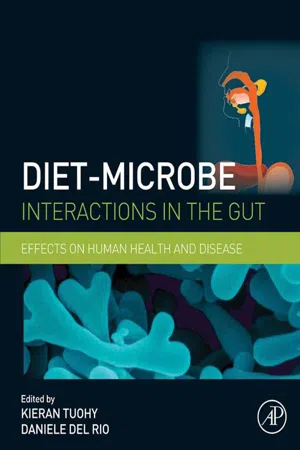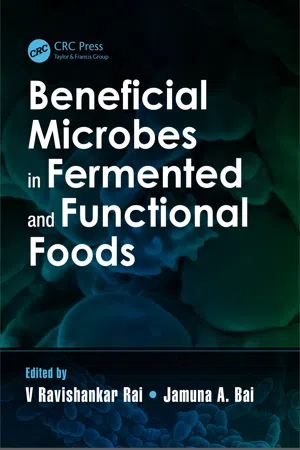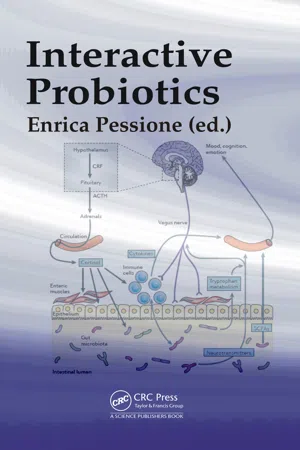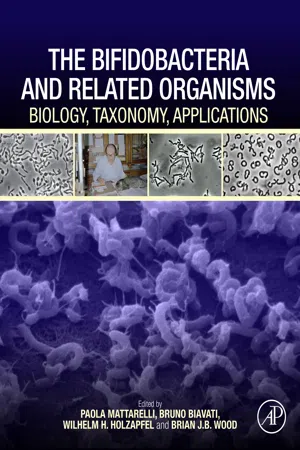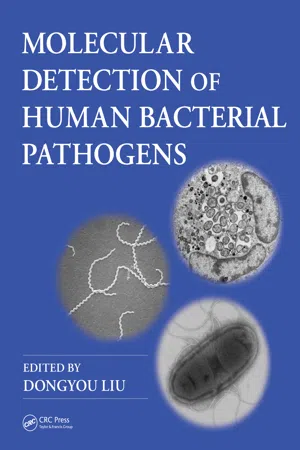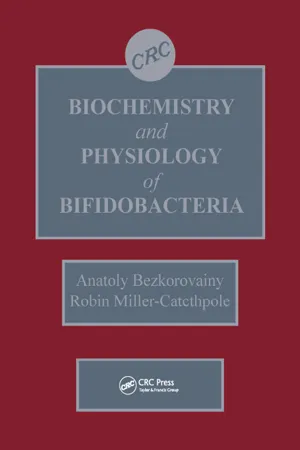Biological Sciences
Bifidobacterium
Bifidobacterium is a genus of bacteria that is commonly found in the gastrointestinal tract of humans and other animals. These bacteria are considered beneficial and are often used as probiotics to promote gut health. Bifidobacterium species are known for their ability to ferment carbohydrates and produce lactic acid, which contributes to a healthy balance of microorganisms in the gut.
Written by Perlego with AI-assistance
Related key terms
1 of 5
8 Key excerpts on "Bifidobacterium"
- eBook - ePub
Diet-Microbe Interactions in the Gut
Effects on Human Health and Disease
- Kieran Tuohy, Daniele Del Rio(Authors)
- 2014(Publication Date)
- Academic Press(Publisher)
Chapter 4Bifidobacteria of the Human Gut
Our Special Friends
Marco Ventura* , Francesca Turroni† and Douwe van Sinderen† , *Laboratory of Probiogenomics, Department of Life Sciences, University of Parma, Italy ,† Alimentary Pharmabiotic Centre and Department of Microbiology, Biosciences Institute, University College Cork, Cork, IrelandMicroorganisms live in a myriad of ecological niches. The human intestine is among the most densely populated environments; here, a multitude of bacteria appears to have co-evolved to beneficially impact on the health of their human host. In this chapter we discuss several fascinating relationships that exist between the mammalian gastrointestinal tract and its resident bifidobacteria, as a prototypical group of health-promoting human enteric microorganisms.Keywords
Gut microbiota; Bifidobacteria; Host–Microbe cross-talk; GenomicTaxonomy of Bifidobacteria
The genus Bifidobacterium belongs to the phylum Actinobacteria , one of the dominant phyla of the kingdom Bacteria, with five subclasses, six orders, and 14 suborders. This phylum includes Gram-positive microorganisms, whose genomic DNA contains a high G+C content, ranging from 51% (Corynebacterium ) to 70% (Streptomyces and Frankia ). An exception to this is the genome of the obligate pathogen Tropheryma whipplei , with less than 50% G+C.1The Actinobacteria phylum includes a large variety of species exhibiting different cell morphologies (from coccoid to fragmenting hyphal), possessing various physiological metabolic properties and occupying diverse ecological niches. With respect to the latter, the phylum Actinobacteria includes genera originating from a wide variety of ecological environments, and includes, among others, soil inhabitants (Streptomyces ), plant commensals (Leifsonia ), nitrogen-fixing symbionts (Frankia ) and gastrointestinal commensals (Bifidobacterium ). Actinobacterial members also include microorganisms that interact with the human host, some of which are disease-causing, examples of which are certain members of the genera Corynebacterium , Mycobacterium , Nocardia , Tropheryma and Propionibacterium , while others represent bacteria exerting health-promoting activities on their hosts such as particular members of the genus Bifidobacterium - Ravishankar Rai V, Jamuna A. Bai, Ravishankar Rai V, Jamuna A. Bai(Authors)
- 2014(Publication Date)
- CRC Press(Publisher)
291 16 Role of Bifidobacteria in the Production of Bioactive Compounds and Detoxification of Harmful Compounds Diana Di Gioia, Francesca Gaggia, Loredana Baffoni, and Verena Stenico 16.1 Bifidobacteria and Their Use as Probiotics The presence of bifidobacteria in the gastrointestinal tract (GIT) of humans has stimulated a lot of inter-est among bacteriologists and nutritionists. Bifidobacteria coexist in the GIT with a large variety of bacteria, most of which are obligate anaerobes. The composition of this complex microbiota is not com-pletely known at present, although new achievements have been made in recent times with the advances in metagenomic technologies (Cani and Delzenne 2011; Turroni et al. 2012). Bifidobacteria provide numerous benefits to the host and, for this reason, are used as probiotics in functional foods and pharmaceuticals. The probiotic concept, referring to the consumption of live microbes to improve the health and well-being of the host, dates back to Metchnikoff (1908). However, the term probiotic was used for the first time only in 1974 to describe “every substance or microorgan-ism that contributes to gastrointestinal balance.” Over time, its meaning has slightly changed. In fact, Fuller (1989) considers probiotic as “a live microbial feed supplement which beneficially affects the host animal by improving its microbial balance.” This definition stresses the importance of viability and avoids the use of the nonspecific term substance . Finally, Haavenar and Huis in’t Veld (1992) used the term probiotic to describe a “mono- or mixed culture of live microorganisms which, when applied to animal or man, beneficially affect the host by improving the properties of the indigenous gastrointestinal CONTENTS 16.1 Bifidobacteria and Their Use as Probiotics ...................................................................................- eBook - PDF
- Enrica Pessione(Author)
- 2014(Publication Date)
- CRC Press(Publisher)
Bifidobacteria and their Interaction with the Gastrointestinal Environment Borja Sánchez, Irene González-Rodríguez, Clara G. de los Reyes-Gavilán, Patricia Ruas-Madiedo and Abelardo Margolles* Introduction Bifidobacteria are members of the Actinobacteria phylum, one of the main phylogenetic groups inhabiting the human intestine. Their abundance in the gut microbiota varies, depending on the population group, but it has been established that they are one of the most prevalent genera, especially in newborns and infants. The mechanisms used by bifidobacteria to counteract the harsh conditions found in our body, as well as the molecular cross-talking dialog that they establish with human cells (i.e., enterocytes and immune cells), has been strongly hampered by the lack of molecular tools to perform functional studies (i.e., knock-out and gene expression systems). However, in recent last years, we have seen a tremendous advance of omics and molecular biology techniques that can be applied to the study of the functional aspects of bifidobacteria (Ventura et al. 2009). This has facilitated 5 * Corresponding author: [email protected] 100 Interactive Probiotics the elucidation of several mechanisms involved in survival, persistence, colonization and downstream responses induced in host cells. This chapter attempts to summarize the current knowledge on these mechanisms. Acidic Conditions in the Stomach In order to reach their ecological niche (the large intestine) alive, bifidobacteria have to cope with the acid stress of both, the fermented food products and of the stomach. Bifidobacteria are consumed as probiotics in fermented milks, where they are added at the beginning of the fermentation process together with the starter culture. Lactose fermentation acidifies milk, which reaches pH values that are usually lower than 4.6 (Gueimonde et al. 2004), thereby causing acid stress to bifidobacteria. - eBook - ePub
The Bifidobacteria and Related Organisms
Biology, Taxonomy, Applications
- Paola Mattarelli, Bruno Biavati, Wilhelm H. Holzapfel, Brian JB Wood(Authors)
- 2017(Publication Date)
- Academic Press(Publisher)
Bifidobacterium , although the availability of the full genomic sequence represents only the first step in the understanding of the biology and metabolic capabilities of these gut commensals.12.2. Ecological origin of bifidobacteria and genetic adaptation to the human gut
The so-far recognized 60 bifidobacterial taxa are basically found within six distinct ecological niches, represented by the human intestine, insect gut, oral cavity, human blood, sewage, and animal gut (Turroni et al., 2011 ). Altogether, this rather diverse ecological distribution is a reflection of the common origin of bifidobacteria from the gut of those animals who subject their progeny to parental care. This ecological origin is sustained by a particular bifidobacterial colonization route, which involves vertical transmission from mother to offspring (Milani et al., 2015b ). In support of this notion, it was recently demonstrated that specific bifidobacterial strains are shared between mother and child (Milani et al., 2015b ).Another intriguing ecological feature of bifidobacteria is represented by their dominance in the gut of mammals at the very early stages of life (Turroni et al., 2012 ). Such findings are further supported by recent discoveries showing that several taxa of the Bifidobacterium genus are genetically adapted to utilize the natural nourishment of infants, that is, breast milk, through the metabolism of particular carbohydrates present in this liquid nutrition (Sela et al., 2008 ). However, human milk should not only be seen as a crucial reservoir of carbohydrates [e.g., lactose and human milk oligosaccharides (HMOs)] or peptides (Oda et al., 2013 ) acting as bifidogenic factors to specifically support growth of particular bifidobacterial species, but may also be an important source of bifidobacterial strains for vertical transmission from mother to child (Milani et al., 2015a ,b - Dongyou Liu(Author)
- 2011(Publication Date)
- CRC Press(Publisher)
Bifidobacterium 49 processingindigestiblecomplexcarbohydratesfromourdiet andfromhostorigin 6,30,37–39 Hence,theavailabilityofgenome sequences of intestinal Bifidobacterium spp, together with theuseofphysiologicalexperiments,hasprovidedconsider-ableinsightintotheadaptationofthisgenustothehumangut environment,especiallyregardingtheutilizationofdietary carbohydrates, resistance to bile and acid conditions, and interactionwiththehost 5.1.3 C LINICAL F EATURES AND P ATHOGENESIS It has been shown that Bifidobacterium is present at high levels in the gut microbiota mainly in infants but also in adults 40 Reduced levels of these microorganisms in the intestineofsubjectssufferingfromdifferentdiseases,includ-ing colon cancer, irritable bowel syndrome, inflammatory bowel disease, atopic disease, or celiac disease, have been observed 41–45 For these reasons several health-promoting propertieshavebeenattributedtothemicroorganismsofthis genusandincreasingbifidobacteriallevelsintheGITisoften atreatmenttargetofdietaryinterventionstrategies Sofar,therehavebeennoreportsofsepsisrelatedtobifi-dobacteria use in otherwise healthy individuals Therefore, the current evidence strongly suggests that bifidobacteria areextremelysafetouseinthegeneralpopulationInfact, the most commonly used Bifidobacterium speciesarecon-sidered to be generally safe (GRAS), and in Europe such microorganismshavebeengrantedaQualifiedPresumption ofSafety(QPS)status 46 Despitethewidespreaduseofthe genus Bifidobacterium ,inparticularthespecies B.- eBook - ePub
- Anatoly Bezkorovainy(Author)
- 2020(Publication Date)
- CRC Press(Publisher)
Microbiol. Immunol., 31, 943, 1987. With permission.The Bifidobacterium may also be an actor in studies on bacterial interactions using gnotobiotic (colonized by a limited number of known bacterial species) and axenic (colonized by a single bacterial species) mice. Thus, B. bifidum but not B. adolescentis was able to suppress the lethal effects of Clostridium difficile in gnotobiotic mice.135Finally, it appears that the type of intestinal flora that exists in a specific animal species, if not human beings, may be genetically predetermined. The NC mice, which normally have no bifidobacteria in their intestinal tracts, may be raised in a germ-free environment. When such NC mice were mated with conventional CF #1 mice that normally harbor bifidobacteria in their intestines, the NC mice did not acquire bifidobacteria. On the other hand, germ-free CF #1 mice, when mated with conventional CF #1 mice, acquired bifidobacteria immediately.136 This is why it is so important to use primate animal models, as was done by Benno et al.,134 if conclusions in regard to human beings are to be made from such data.IV. SUMMARY
Bifidobacteria are present in the colons of all human age groups. Most extensive studies in this area have been done with the purpose of delineating the basis and reasons for why bifidobacteria predominate in the colons of breast-fed infants, but not in bottle-fed infants and adults. The result of this difference is that the fecal pH of the former group is about 5, whereas that of the latter group is around 7. The relatively low pH in the first group prevents the growth of pathogenic microorganisms, and thus prevents infections. It has been proposed that the components of human milk favor the development of bifidobacterial flora in the breast-fed infants. One possibility is the low buffering capacity of human milk compared with that of bovine milk; the other is that human but not cow milk contains a number of bifidobacterial growth factors. The growth requirements of B. bifidum var. pennsylvanicus have been most extensively investigated. This organism requires N-acetylglucosamine-containing oligosaccharides for growth, which are present in human but not cow milk. The N - Ronald Ross Watson, Ram B. Singh, Toru Takahashi(Authors)
- 2018(Publication Date)
- Academic Press(Publisher)
Its use is currently an attractive strategy to upregulate disordered intestinal function and to improve nutritional status. Experiments into the benefits of probiotic therapies suggest a range of potentially beneficial medicinal uses for probiotics. For many of the potential benefits, research is limited and only preliminary results are available. Recent research on the molecular biology and genomics of Lactobacillus has focused on the interaction with the immune system, anticancer potential, and potential as a biotherapeutic agent in cases of antibiotic-associated diarrhea, travelers’ diarrhea, pediatric diarrhea, inflammatory bowel disease, and irritable bowel syndrome. All effects can only be attributed to the individual strain(s) tested. Testing of a supplement does not indicate benefit from any other strain of the same species, and testing does not indicate benefit from the whole group of LAB (or other probiotics). Bifidobacterium animalis is the most common probiotic species used in foods, as it possesses the highest tolerance to oxygen and acids. The continued adaptation of this species to the fermented dairy environment resulted in the evolution of a subspecies of B. animalis subsp. lactis strain Bb-12, which is commercially available as a probiotic on the retail market and is exclusively supplied by Chr. Hansen Inc., a worldwide supplier of fermentation cultures. Bifidobacteria are generally believed to contribute to good intestinal health, and attempts have been made to increase their numbers in the intestine by including them in certain foods as probiotics. They are frequently included in yogurts together with prebiotics, such as inulin or fructo oligosaccharides, the combination of which can be referred to as a symbiotic yogurt- eBook - ePub
Microbiome, Immunity, Digestive Health and Nutrition
Epidemiology, Pathophysiology, Prevention and Treatment
- Debasis Bagchi, Bernard William Downs, Bernard W. Downs(Authors)
- 2022(Publication Date)
- Academic Press(Publisher)
Den Besten et al., 2013 ).Ruminococcus, Prevotella, Firmicutes, and Bacteroides are all large families of bacteria that are present in the human gut. The anaerobic bacteria Bifidobacterium , Peptostreptococcus , Clostridium , and Lactobacillus live in the colon, which is low in oxygen (Arumugam et al., 2011 ). These microbes may prevent harmful bacteria from multiplying by competing for important nutrients and attachment sites on the gut mucus membrane, which play a major part in the immune system and antimicrobial protein production (Canny and McCormick, 2008 ; Jandhyala et al., 2015 ). Some beneficial and harmful bacteria are shown in Fig. 4.2 . Early postnatal environmental exposures play a crucial role in shaping the overall phylogenetic structure of the adult human gut microbiome, according to metagenomic analyses of the human gut microbiome. During the first initial three years of life (Koenig et al., 2011 ), the microbiota is assembled into an adult configuration; properties of the organism and gene gut communities are shared across family members and passed down through generations (Turnbaugh et al., 2009 ). There are thousands of different varieties of bacteria in the intestines, the majority of which are beneficial to human health (Fig. 4.3 ) and perform various functions that are beneficial for health. On the other hand, the presence of harmful microorganisms can lead to disease. Gut dysbiosis is a condition in which the balance between good and bad microorganisms is disturbed, and it can potentially lead to gaining of weight (Patterson et al., 2016 ). Several studies have shown that the gut microbiotas of identical twins, one who is fat while the other is lean, differ dramatically. This substantiates the hypothesis that those changes in the microbiome are not due to genetic differences (Ridaura et al., 2013 ; Turnbaugh et al., 2009 ). Although both groups ate the same foods, the twin who was obese had a microbiota that was different from the microbiota of the lean twin (Ridaura et al., 2013
Index pages curate the most relevant extracts from our library of academic textbooks. They’ve been created using an in-house natural language model (NLM), each adding context and meaning to key research topics.
